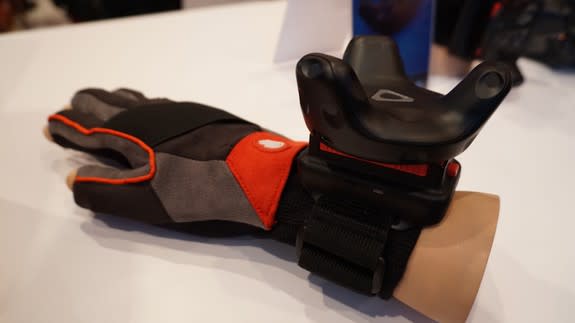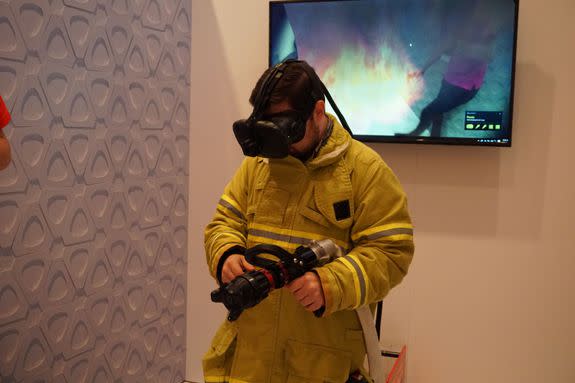HTC unveils Vive accessory that turns real objects into VR controllers

LAS VEGAS — At CES 2017, HTC announced two new accessories that expand on the Vive VR headset's capabilities.
The first is a small attachment called the Vive Tracker that enables motion tracking for real, physical objects and imports them into the VR world.
SEE ALSO: LG's new 4K TV is thinner than an iPhone
For example, clip the Tracker to the end of a physical baseball bat and your real swings will translate into the VR world.
Or connect the Tracker to a pair of VR gloves and — boom — your hands and fingers are replicated in VR with full finger-tracking.
Or attach the Tracker to a blaster and pull on its trigger — it'll fire like a real gun in VR.
The idea is to expand the number of control methods in VR beyond the default Vive controllers. With the Tracker, any object can essentially become a controller of sorts.

Image: raymond wong/mashable

Image: RAYMOND WONG/MASHABLE

Image: RAYMOND WONG/MASHABLE
"We want to make it even easier for developers to prototype and market more immersive controllers and accessories," said Daniel O’Brien, general manager for HTC Vive. "The Vive Tracker is the first step in growing an ecosystem of third-party accessories that will change how we interact with virtual experiences and provide consumers and businesses with an unlimited amount of content opportunities."
HTC says it's not difficult to add object-tracking support to apps and games. One developer said it only took about four hours to integrate the Tracker into its firefighting simulator that turns a hose into a controller.
The Tracker is intriguing for obvious reasons, but it raises a safety concern. Imagine attaching the Tracker to objects like a baseball bat that you'll swing around — one slip-up on the bat's handle and you could be looking at a shattered TV, black eye or worse.
Still, it's kind of nice to have more controller options. One impressive demo involved attaching the Tracker to a camera-like device, so the player could take different pictures at various angles using the contraption:

Image: raymond wong/mashable
The Vive Tracker will launch in Q2. Pricing will be announced at a later date.


Image: RAYMOND WONG/MASHABLE
The other new accessory is called the Vive Deluxe Audio Strap. Right now, when you buy a Vive, you have to use your own headphones — yet another cable to manage.
With the Deluxe Audio Strap, Vive users get an integrated pair of headphones on the head strap similar to the one on the Oculus Rift.
Users will still get a 360-degree audio experience, and the ear cups are conveniently adjustable. It's definitely a less cluttered and cleaner VR experience than using your own pair of headphones.

Image: RAYMOND WONG/MASHABLE
"We’ve continuously improved the core Vive experience, making it more comfortable and easier to use," O’Brien said. "The Deluxe Audio Strap evolves this mission further, offering a seamless audio solution that also fits more comfortably for Vive users."
The Deluxe Audio Strap will be available in the second quarter of this year, and pricing will be announced closer to the launch date.

Image: RAYMOND WONG/MASHABLE
Finally, HTC took a brief moment to address wireless functionality. Currently, the Vive must be shackled to a PC via a mess of cables, which is a drag.
Though HTC didn't have anything official to show off, the company says it's working closely with Intel on a WiGig accessory that'll provide the kind of high-bandwidth wireless transfers that the Vive requires. More will be revealed in the future.
In the meantime, TPCast, a wireless adapter solution that helps cut the cord, will be coming in Q2 for $249.
